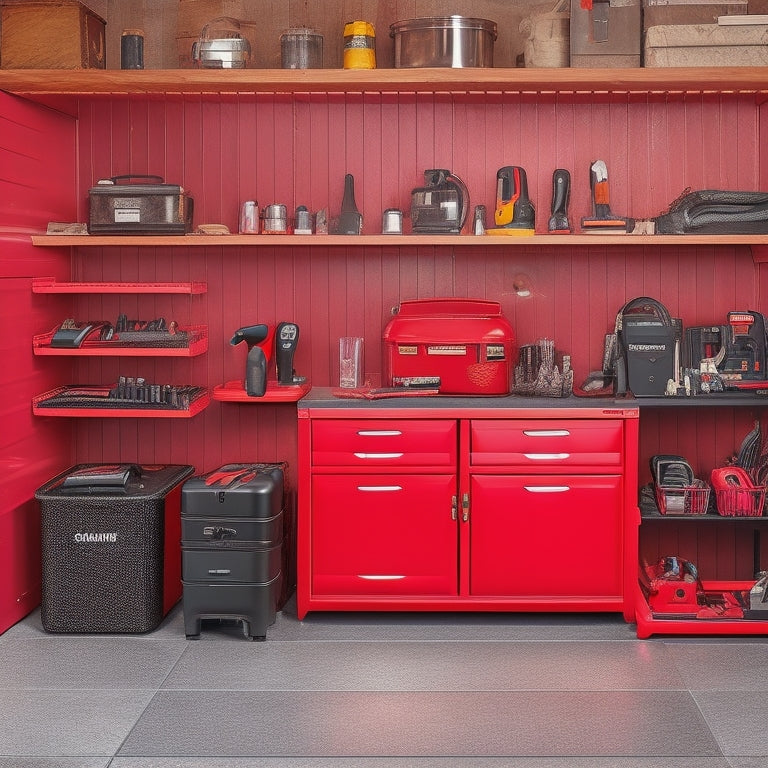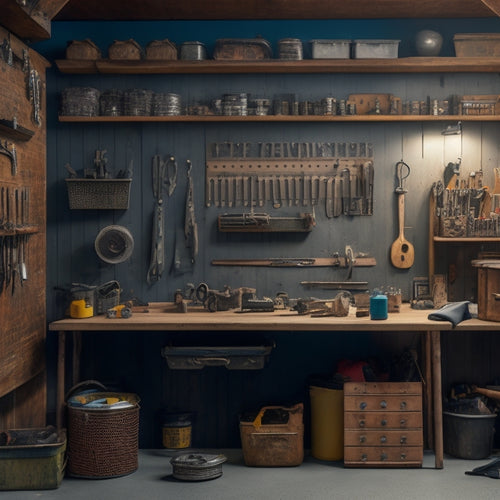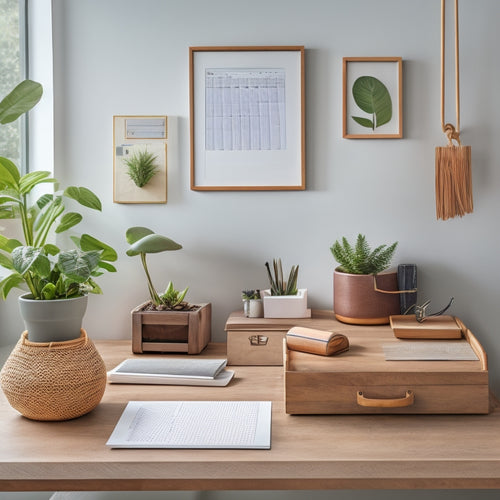
Nearby Tool Box for Homeowners
Share
With a nearby toolbox at your fingertips, you'll be well-equipped to tackle minor repairs, maintenance tasks, and DIY projects with confidence and self-sufficiency. A well-stocked toolbox should meet safety standards, be durable, and provide comfortable handling. Essential tools include hammers, pliers, screwdrivers, and tape measures. Having these tools nearby enables efficient tackling of quick fixes, facilitates routine maintenance, and provides immediate access during emergencies. By investing in essential tools, you'll save time and money while gaining control over home upkeep. As you build your toolbox, you'll uncover the benefits of being prepared for any task that comes your way, and you'll be ready to take on whatever's next.
Key Takeaways
- A well-stocked toolbox nearby enables efficient tackling of quick fixes, facilitates routine maintenance, and provides immediate access during emergencies.
- Essential tools include a hammer, pliers, screwdrivers, and tape measure, which should meet safety standards, be durable, and comfortable to use.
- A nearby toolbox saves time and money by reducing reliance on professionals, and encourages timely repairs to prevent larger issues and costs.
- Organize tools by function or type, and use adjustable dividers, removable trays, and stackable bins to maximize space and accessibility.
- Regularly assess and adjust toolbox organization, clean and maintain tools, and replace worn-out tools to ensure safety and efficiency.
Tool Box Essentials for Homeowners
With your toolbox's organization and maintenance underway, it's time to focus on the essential tools that will help you tackle various tasks and projects around the house. As a homeowner, you'll want to prioritize tool selection criteria that guarantee you're choosing the right tools for the job.
Look for tools that meet safety standards, are durable, and fit comfortably in your hand. A hammer, pliers, screwdrivers, and a tape measure are must-haves for any toolbox.
When selecting tools, consider the specific tasks you'll be performing and the materials you'll be working with. For example, if you'll be working with wood, a cordless drill and bits are essential.
Toolbox safety tips include storing tools in a dry, well-ventilated area, keeping sharp objects away from children, and regularly inspecting tools for damage or wear.
Additionally, always follow the manufacturer's instructions and take regular breaks to avoid fatigue. By following these guidelines, you'll be well-equipped to tackle a variety of projects around the house while maintaining a safe and organized workspace.
Benefits of Having a Toolbox Nearby
Having a toolbox nearby enables you to tackle quick fixes efficiently, as you'll have the necessary tools at your fingertips to address minor issues before they escalate into major problems.
This proximity also allows you to stay on top of routine maintenance, ensuring your home remains in top condition.
Handy for Quick Fixes
At the most inopportune moments, household items tend to break or malfunction, leaving you scrambling to find a solution. Having a nearby tool box can be a lifesaver in such situations.
With a well-stocked tool box, you'll be equipped to tackle quick repairs and DIY projects with ease. When a faucet starts leaking or a shelf collapses, you won't need to wait for a handyman or waste time searching for the right tools. Your nearby tool box will have everything you need to fix the issue promptly. This not only saves you time but also helps prevent further damage or safety hazards.
Moreover, having the right tools at your fingertips can give you the confidence to take on more DIY projects, saving you money and increasing your sense of self-sufficiency.
From tightening loose screws to replacing light fixtures, a nearby tool box will become your go-to solution for quick fixes and minor repairs. With the right tools, you'll be enabled to tackle any unexpected issue that arises, ensuring your home remains safe, secure, and well-maintained.
Essential for Maintenance
You'll find that a nearby tool box is also crucial for routine maintenance tasks, helping you stay on top of your home's upkeep and preventing costly repairs down the line. By having the right tools at your fingertips, you can tackle tasks like inspecting and replacing air filters, cleaning gutters, and lubricating door hinges with ease.
This, in turn, helps maintain your home's systems and prevents minor issues from escalating into major problems.
When it comes to tool selection tips, focus on stocking your box with essentials like pliers, screwdrivers, and wrenches. These will cover most basic maintenance tasks. Additionally, consider the specific needs of your home, such as a drain snake for clogged pipes or a stud finder for hanging heavy objects.
To guarantee you stay on top of maintenance, create a scheduling system that works for you. Set notifications for tasks like seasonal HVAC maintenance or annual fire extinguisher inspections.
Saves Time and Money
A well-stocked toolbox within arm's reach translates to significant time and cost savings for homeowners. When you have the right tools nearby, you can tackle minor repairs and maintenance tasks quickly and efficiently, saving you time and money in the long run.
Without a toolbox, you'll likely find yourself making frequent trips to the hardware store or calling in a professional, which can be costly and time-consuming.
Having a nearby toolbox stocked with budget-friendly options like pliers, screwdrivers, and wrenches means you can take care of small tasks on your own, without breaking the bank.
You'll also be less likely to put off necessary repairs, which can lead to more extensive and expensive problems down the line.
By investing in a few essential tools, you'll be able to implement time-saving hacks like fixing leaky faucets, tightening loose screws, and replacing air filters, all of which can add up to significant savings over time.
With a nearby toolbox, you'll be enabled to take control of your home's maintenance and repairs, saving you both time and money in the process.
Common Tools Found in a Toolbox
As you open the lid of your trusty toolbox, you're immediately greeted by a medley of instruments designed to tackle various tasks around the house. Among the most essential tools are screwdrivers, available in flathead, Phillips, and Torx types, each suited for specific fasteners.
Hammers come in varieties like claw, ball-peen, and sledgehammers, serving purposes from driving nails to breaking apart objects. Wrenches, ranging from adjustable to fixed sizes, help with tightening and loosening bolts and nuts.
Pliers are used for gripping and bending objects, while saws, including handsaws, circular saws, and reciprocating saws, are used for cutting materials. A tape measure guarantees accurate measurements, and a level assures proper placement.
Drill types, such as cordless, corded, and hammer drills, cater to different drilling needs. A utility knife is handy for miscellaneous cutting tasks.
When working with these tools, prioritize tool safety by following proper usage guidelines and wearing protective gear to avoid accidents.
How to Organize Your Toolbox Efficiently
You'll need to carefully plan your toolbox layout to guarantee easy access to frequently used tools, optimize storage for less-used items, and implement organizational strategies that make sense for your specific needs.
By doing so, you'll be able to maximize your toolbox's storage capacity and reduce the time spent searching for tools.
As you organize your toolbox, consider the types of projects you typically undertake and allocate space accordingly, using efficient storage solutions to keep your tools within easy reach.
Toolbox Layout Essentials
Organizing your toolbox efficiently starts with a well-thought-out layout, allowing you to quickly locate and retrieve the tools you need. This is particularly important for homeowners who require instant access to tools during emergency repairs or maintenance tasks.
A well-designed layout enables you to identify the tools you need at a glance, reducing the risk of accidents caused by delayed responses.
When designing your toolbox layout, consider the tools you use most frequently and allocate prime space for them. Toolbox customization options, such as adjustable dividers and removable trays, can help you create a customized layout that suits your specific needs.
Portable toolbox designs, on the other hand, offer flexibility and convenience, allowing you to transport your tools to the worksite.
To maximize storage capacity, categorize your tools by function or type, and store them in designated zones within the toolbox. This segregation prevents tools from getting jumbled and lost, reducing the risk of damage or misplacement.
Tool Organization Strategies
By allocating prime space to frequently used tools, you've set the stage for efficient toolbox organization.
Now, it's time to fine-tune your toolbox by implementing strategies that promote ease of access and reduce clutter.
To optimize your toolbox, consider the following tool organization strategies:
-
Categorize and group tools: Store similar tools together, such as all screwdrivers in one section and all wrenches in another. This makes it easier to find what you need when you need it.
-
Implement a "first-in, first-out" policy: Store new tools behind existing ones to guarantee older tools are used before they expire or become obsolete.
-
Label and sign tools: Clearly label each tool and its designated storage space to prevent misplacement and confusion.
- Store heavy tools at the bottom: Place heavier tools at the bottom of your toolbox to prevent them from falling and causing injury or damage.
Efficient Storage Solutions
Your toolbox's efficient storage solutions hinge on maximizing every available inch, minimizing clutter, and ensuring instant access to the tools you need. To achieve this, you'll need to implement space-saving techniques that prioritize functionality over aesthetics.
Start by categorizing your tools into groups based on frequency of use, size, and type. This will help you determine the most effective storage layout for your toolbox.
Multi-purpose containers are a great way to enhance storage space. Consider using stackable bins, dividers, and trays to separate and organize your tools. Label each container clearly, so you can quickly identify what's inside.
You can also employ vertical space by installing pegboards or hooks to hang tools like hammers, saws, and wrenches.
When selecting storage solutions, prioritize durability and safety. Look for containers with secure latches and consider adding a locking mechanism to prevent unauthorized access.
Toolbox Maintenance and Upkeep Tips
Efficiency hinges on a well-maintained toolbox, where every tool is readily accessible and in prime working condition.
Regular maintenance is vital to guarantee your tools remain in top shape, and you can tackle tasks efficiently and safely.
To keep your toolbox in peak condition, follow these essential maintenance tips:
-
Implement a regular cleaning routine using toolbox cleaning techniques, such as wiping down tools with a soft cloth and gentle cleaning products to prevent rust and corrosion.
-
Schedule a toolbox inspection frequency of at least every three months to identify and address any issues promptly, like worn-out tool handles or damaged electrical cords.
-
Organize your tools in a logical and accessible manner, grouping similar tools together and storing them in designated compartments.
- Perform tool sharpness checks and maintenance tasks, such as sharpening dull blades or replacing worn-out bits, to guarantee your tools remain effective and safe to use.
Creating a Toolbox on a Budget
As you've perfected your toolbox maintenance routine, it's time to focus on building an all-encompassing toolbox without breaking the bank. You don't need to sacrifice quality for affordability; instead, prioritize essential toolkits and multi-purpose tools that cater to your DIY project needs.
Start by selecting budget-friendly tools that meet your requirements. Look for local discounts, promotions, or second-hand shops for affordable options.
Consider storage ideas that optimize your toolbox's space, such as stackable containers or hanging organizers, to keep your tools organized and within reach.
Tool safety is paramount, so make sure you're investing in tools that meet industry standards. Beginner tools, like a hammer or pliers, are must-haves for any DIY enthusiast.
As you progress, you can customize your toolbox with specialized tools specific to your projects. Toolbox customization doesn't have to be expensive; repurpose old items or get creative with DIY storage solutions.
Frequently Asked Questions
Can I Store My Toolbox in a Humid Basement or Garage?
You shouldn't store your toolbox in a humid basement or garage, as high humidity accelerates rust and corrosion, compromising your tools' integrity; instead, implement rust prevention measures, like silica gel packets or a dehumidifier, to maintain a dry environment.
Are Toolboxes Suitable for Apartments With Limited Storage Space?
When living in an apartment with limited storage space, you'll benefit from compact tool solutions that maximize space efficiency, such as multi-functional storage units that keep your tools organized, secure, and easily accessible.
How Often Should I Clean and Inspect My Toolbox?
As you rummage through your trusty toolbox, remember to dust off the cobwebs of neglect: clean and inspect it every 3-6 months to confirm tool maintenance and toolbox organization, assuring safety and precision in your DIY pursuits.
Can I Add Custom Tools to a Pre-Assembled Toolbox?
You can modify your pre-assembled toolbox to fit your needs by adding custom tools, ensuring proper custom tool organization. Investigate toolbox modification options, considering safety and functionality, to create a customized space that enhances your workflow and reduces clutter.
Are There Any Specific Safety Considerations for Toolbox Storage?
When storing your toolbox, you'll want to prioritize toolbox organization to avoid safety hazards; make certain tools are securely stored, cords are untangled, and sharp objects are protected to prevent tripping, electrical shocks, and cuts.
Conclusion
Having a nearby tool box is not just a convenience, it's a necessity for homeowners. Research reveals that homeowners who have a well-stocked toolbox nearby are more likely to tackle DIY projects, resulting in an average annual savings of $1,300 on professional labor costs. By following the tips outlined in this article, you'll be well on your way to creating an all-encompassing toolbox that will save you time, money, and frustration, ultimately making you a more self-sufficient homeowner.
Related Posts
-

Design Considerations for a Custom Pegboard
When designing a custom pegboard, you'll want to start by evaluating your storage needs, considering factors like too...
-

Best Organizing Tools for a Clutter-Free Space
You're on a mission to change your cluttered space into a peaceful oasis, and you're looking for the best organizing ...
-

Custom Pegboard Storage for Your Workshop
You're looking to create a custom pegboard storage system that maximizes your workshop's space, enhances productivity...


